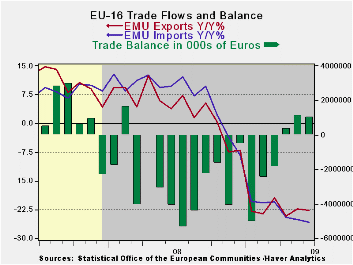 Global| Aug 17 2009
Global| Aug 17 2009EMU Trade Surplus Is On An A Slight Up-Trend Signs Of Real Recovery Remain Elusive
Summary
Exports have the better trend among bad results EMU exports and imports are still on life support in terms of their year-over-year drops. But exports are showing slightly more life in recent months. Apart from splitting hairs, exports [...]

Exports have the better trend among bad results
EMU exports and imports are still on life support in terms of their
year-over-year drops. But exports are showing slightly more life in
recent months. Apart from splitting hairs, exports and imports were
roughly flat in June.
The end of the end but where is the new beginning?
Although there has been some pick up in orders for industrial goods,
exports themselves are not popping in Europe. Europe is getting ready
to exit recession based on the fact that the EMU’s GDP barely fell in
2009-Q2 as Germany and France posted positive GDP growth numbers.
Today, Japan posted an increase in its Q2 GDP so the list of countries
exiting recession is growing. Yet, some of those exiting recession do
not seem to have very good breadth or strength to the various key
economic sectors that need to drive and sustain a true recovery.
Technical recovery
The economies exiting recession are doing so rather narrowly on barely
positive GDP without much breadth or momentum to their turnaround
raising questions about the strength of recovery as well as about its
sustainability. The OECD leading indicators see a lot of momentum shift
in Europe, but not so much lift in Japan. Both Europe and Japan depend
a lot on trade for growth. The U is the sole country in this group of
four that has not yet posted positive GDP. But the US is, in contrast,
showing a lot of upward momentum as well as decreased downward
momentum; it has trimmed its deep negative growth rates across most
sectors and business cycle measures. US GDP only fell at a -1% annual
rate in 2009-Q2. It too, Like EMU, is on the brink of recovery.
Searching for Mr. Good -Growth
For Europe the end of recession is not being created by much if any
increase in consumer spending. Business fixed investment is still
chilled. And as we see here exports have the smallest of possible
upward gradients in train. While recessions have been deemed as
technically over in a number of countries I think we are still on the
outlook for a real recovery anywhere.
| E- Area 16-Trade trends for goods | ||||||
|---|---|---|---|---|---|---|
| M/M% | % Saar | |||||
| Jun-09 | May-09 | 3M | 6M | 12M | 12M Ago | |
| Balance* | €€ 1,042 | €€ 1,108 | €€ (2,399) | €€ (1,142) | €€ (481) | €€ 698 |
| Exports | ||||||
| All Exp | -0.1% | -1.8% | -10.3% | -24.8% | -22.8% | 3.9% |
| Food and Drinks | 0.0% | -2.0% | -7.6% | -16.6% | -9.9% | 10.9% |
| Raw materials | 0.4% | 2.2% | 16.0% | 8.8% | -21.2% | 7.7% |
| Other | -0.1% | -1.9% | -11.0% | -26.0% | -23.7% | 3.4% |
| MFG | -3.0% | -2.3% | -25.4% | -30.7% | -25.2% | 1.0% |
| IMPORTS | ||||||
| All IMP | 0.0% | -2.5% | -19.8% | -26.9% | -25.9% | 9.8% |
| Food and Drinks | -2.8% | -2.6% | -34.5% | -15.3% | -8.8% | 8.0% |
| Raw materials | -0.8% | -4.1% | -35.8% | -59.5% | -42.4% | 4.8% |
| Other | 0.2% | -2.5% | -17.7% | -25.7% | -26.0% | 10.1% |
| MFG | -2.5% | -1.7% | -29.8% | -29.1% | -23.2% | -0.2% |
| *Eur mlns; mo or period average | ||||||
Robert Brusca
AuthorMore in Author Profile »Robert A. Brusca is Chief Economist of Fact and Opinion Economics, a consulting firm he founded in Manhattan. He has been an economist on Wall Street for over 25 years. He has visited central banking and large institutional clients in over 30 countries in his career as an economist. Mr. Brusca was a Divisional Research Chief at the Federal Reserve Bank of NY (Chief of the International Financial markets Division), a Fed Watcher at Irving Trust and Chief Economist at Nikko Securities International. He is widely quoted and appears in various media. Mr. Brusca holds an MA and Ph.D. in economics from Michigan State University and a BA in Economics from the University of Michigan. His research pursues his strong interests in non aligned policy economics as well as international economics. FAO Economics’ research targets investors to assist them in making better investment decisions in stocks, bonds and in a variety of international assets. The company does not manage money and has no conflicts in giving economic advice.






